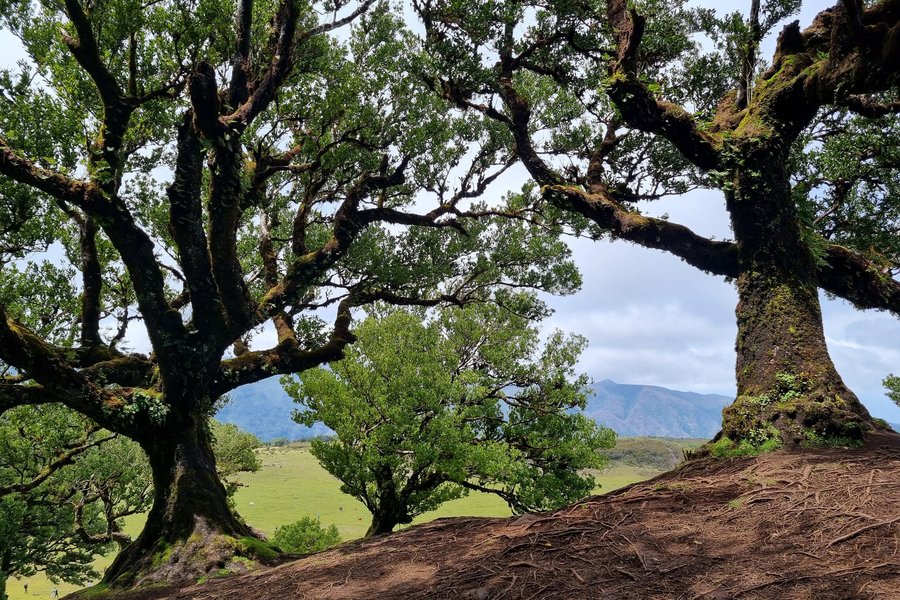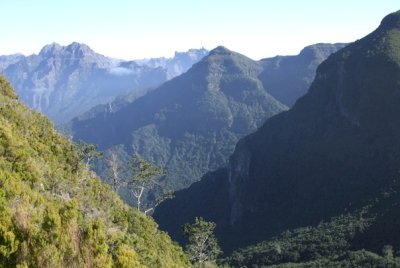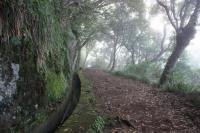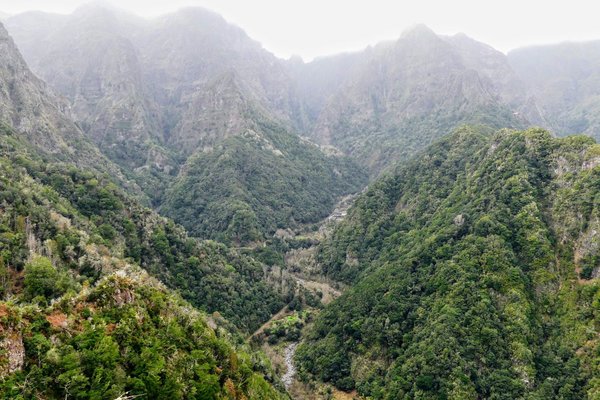Portugal
Laurisilva of Madeira
The Laurisilva of Madeira is a relict of a previously widespread laurel forest type, that is important for biodiversity conservation.
This primary laurel forest within the Parque Natural da Madeira holds evergreen trees and bushes in very steep valleys. It is home to a variety of species endemic to Madeira, such as over 70 vascular plant species, 500 species of invertebrates, the Madeiran Laurel Pigeon and the Madeira Pipistrelle. Moss and lichen species, threatened elsewhere, are abundant.
Community Perspective: Be aware that this site is not equal to the National Park, but consists of patches of forest in the northern section. Recommended starting points to access the forest are in Ribeiro Frio (easy trail to the Balcoes panoramic viewpoint), Rabacal (hiking the Levada 25 Fontes or to the waterfall Cabo do Risco).
Site Info
Official Information
- Full Name
- Laurisilva of Madeira (ID: 934)
- Country
- Portugal
- Status
-
Inscribed 1999
Site history
History of Laurisilva of Madeira
- 1999: Inscribed
- Inscribed
- Type
- Natural
- Criteria
- ix
- x
Links
- UNESCO
- whc.unesco.org
- Official
-
- visitportugal.com — Visit Portugal: Laurissilva Forest
All Links
UNESCO.org
- whc.unesco.org — whc.unesco.org/
Official Website
- visitportugal.com — Visit Portugal: Laurissilva Forest
News Article
- Nov. 6, 2024 thisismadeiraisland.com — Madeira introduces hiking fees
Community Information
- Community Category
- Natural landscape: Forest
Travel Information
Not for Acrophobes
Recent Connections
-
Perfect Inscriptions
1999 -
Incorrect UNESCO 'Number of locations'
There seems to be only 1 official locat… -
Not for Acrophobes
Levada 25 Fontes and the Cabo do Risco …
Connections of Laurisilva of Madeira
- Geography
-
-
Atlantic Ocean
Laurel forest is specific to the North Atlantic -
Macaronesia
-
- Trivia
-
-
On Passports
Portuguese passportSee www.pep.pt
-
Depicted in Mizielinska Maps
See i.pinimg.com
-
- Ecology
-
-
Endemic Bird Species
Madeira and the Canary Islands - Madeira Laurel Pigeon (Columba trocaz), Plain Swift (Apus unicolor),See www.birdlife.org
-
Notable examples of island gigantism
Giant Parsley -
Molluscs
Crit x "In the Laurisilva there are more than 500 endemic species of invertebrates, including insects, arachnids and mollusks" -
Cloud forest
laurel forest (laurisilva), a type of mountain cloud forest (UNEP-WCMC)
-
- World Heritage Process
-
-
Incorrect UNESCO 'Number of locations'
There seems to be only 1 official location, but it consists of multiple elements that are not contiguous. Protected Planet shows them as 9 separate areas. -
Perfect Inscriptions
1999
-
- Human Activity
-
-
Irrigation and drainage
The levadas provide essential drinking water and irrigation supplies (Unesco website)
-
- Constructions
-
-
Tunnels
Many Levadas include Tunnels ("To get through the central ridge, tunnels as long as 5km were constructed. Besides the levadas, including in the tunnels, are paths typically 1-2m wide, which allow access to the otherwise almost impenetrable forest" AB Eval & Nom File). E.g (within the inscribed area)
-
- WHS on Other Lists
-
-
Biodiversity hotspot
Mediterranean Basin -
World Heritage Forest Programme
-
Located in a TCC Territory
Madeira -
Centres of Plant Diversity
AO3 Madeira (including the Salvage Islands) - "A large proportion of its plants and animals are unique to the laurel forest, and it is larger than and with significant differences to other laurel forest areas." -
Natura 2000
See ec.europa.eu
-
- Timeline
-
-
Miocene
"The volcano formed atop an east-west rift in the oceanic crust along the African Plate, beginning during the Miocene epoch over 5 million years ago, continuing into the Pleistocene until about 700,000 years ago. This was followed by extensive erosion, producing two large amphitheatres open to south in the central part of the island." Wiki
-
- Visiting conditions
-
-
Not for Acrophobes
Levada 25 Fontes and the Cabo do Risco trails
-
- WHS Names
-
-
Named after a Tree Species
Named after the plant family Laurels, and "Endemic trees belonging to the Lauraceae family such as the Barbusano Apollonias barbujana ssp. Barbujana, the Laurel Laurus novocanariensis, the Til Ocotea foetens and the Vinhático Persea indica are dominant." (OUV)
-
News
- thisismadeiraisland.com 11/06/2024
- Madeira introduces hiking fees
Recent Visitors
Visitors of Laurisilva of Madeira
- Adrian
- Aitia
- Alexander Lehmann
- Ali Zingstra
- A. Mehmet Haksever
- Ana Lozano
- Argo
- Atila Ege
- Attiska
- AustralLights
- AYB
- Bin
- Bodil Ankerly
- Bram de Bruin
- Brendan Carroll
- Bropyk
- Caspar
- chenqtao
- Cheryl
- Christravelblog
- Claire Bradshaw
- Clyde
- Dani Cyr
- Daniel Chazad
- debatecoach
- del
- Dimitar Krastev
- Elis
- Ellen Nielsen
- Els Slots
- Eva Kisgyorgy
- Evgenii
- Fan Yibo
- Farinelli
- Francky D'Hoop
- Frédéric M
- FS
- Geert Luiken
- George Gdanski
- Gernot
- Hadrianus
- HaraldOest
- Harald T.
- Harry Mitsidis
- Hubert
- Iain Jackson
- Iara
- Ivan Rucek
- Jacob Otten
- Jana and Matt
- janameerman
- Jan-Willem
- Jarek Pokrzywnicki
- Jasam
- Jay T
- Jonoprout
- JR's HERITAGE SITES
- Juha Sjoeblom
- KeithBailey
- Kevin247
- Kevin Padley-Knight
- Klaus Freisinger
- Krzysztof B
- Laurine
- Leonie Geurts
- Loic Pedras
- Luboang
- Luis Filipe Gaspar
- Lukasz Palczewski
- Maciej Gil
- Matejicek
- Mateusz
- Michael Novins
- michaelsballard
- Michael Turtle
- Mikko
- Mohboh
- nan
- napalm
- Nick Kuzmyak
- Nick M
- Nihal Ege
- Patrik
- Patrik_globe
- peacemaker2142
- Peter Lööv
- Petteri
- pghgeekgrrl
- phillipmeng
- Pincze
- Pink Bunny
- Piotr Wasil
- Randi Thomsen
- Reza
- Rick Ohm
- Rodinia
- Roger Enarsson
- Roger Ourset
- Roman Bruehwiler
- Sandra!
- Sehnsuchtsbummler
- serghei.belous
- Slavi
- Solivagant
- Stanislaw Warwas
- Stijn
- Svein Elias
- Szucs Tamas
- Tarquinio_Superbo
- Thomas Buechler
- Thomas van der Walt
- TimCC
- Timothy C Easton
- Tinamu
- Tom Flaten
- travellingcat
- triath
- Vanessa Buechler
- Van Hung
- VB73
- V&M
- Walter
- Wojciech Fedoruk
- wolfboy
- Zoë Sheng
Community Reviews
Show full reviews
My friend and I visited the Laurisilva of Madeira during a 10-day stay on the island in May 2025. Thanks to our rental car, we were able to visit several areas of the core zone listed as WHS.The forest is located mainly on the northern slopes of the island, the southern slopes having been deforested after the island's discovery by the first settlers. Without our car, I think we would have had great difficulty accessing some areas located in the west or center of the island. The eastern part, the most accessible from Funchal, is also the most fragmented and most visited by tourists, especially the area around Ribeiro Frio ("Balcoes promenade"). If possible, it is better to come (very) early in the morning or late in the afternoon. This area gives a glimpse of the laurisilva but I strongly advise not to limit yourself to this sector because it does not allow you to feel totally immersed in this magnificent primary forest. The northeast section is easily visited, particularly along the levada do Caldeirao Verde or levada do Rei. I recommend visiting the latter, as it's (slightly) less crowded. After crossing an area populated by eucalyptus trees, you quickly find yourself in the heart of the laurel forest (Laurus azorica and Persea indica). As a bonus, this also allows you to explore a levada that could be listed soon, if Portugal maintains it in its new nomination for the levadas of Madeira. The central part is located …
Keep reading 0 comments
I explored and enjoyed the primeval forests of Madeira very intensively during my visit in January 2012. I spent almost one week in the forested area of Madeira staying overnight in tent and sleeping bag.
The Laurisilva used to cover the entire area of the island (maybe with exception of Sao Lourenco peninsula). Now, it can be found in 4 clusters, and I had opportunity to visit all of them: (1) the large valley of Ribeira Da Janela river. The touristy part of this cluster is Levada das 25 fontes area around Rabacal; (2) Area between Paul da Serra plateau and Sao Vicente; (3) Area between Pico Ruivo and Santana; and (4) quite small cluster around Ribeiro Frio, which is one of the top tourist destination in Madeira. The parts 1-3 are linked together, while the cluster 4 is separated. There are also large areas in the central parts of the island around Pico Ruivo and Pico Grande that were strongly affected by fire, what I could see in 2012.
The Laurisilva is very dense forest, but due to a rocky character of Madeira and a presence of levadas one can enjoy wonderfull views there. I like all of the mentioned clusters, but I have maybe the best memories on the cluster No 2, which was the most remote and wildest (see photo).
Keep reading 0 commentsMadeira was my first stop on a December 2016 tour of Portugal and Spain. One experiences this WHS by hiking the ‘levada trails’, which are walking routes that follow man-made irrigation channels known as levadas. The levadas generally flow horizontally along the contours of the hills, with occasional descents down the slopes.
The most striking things about driving up from our hotel by the coast up to the laurisilva forests in Madeira’s uplands were the changes in weather and vegetation. The temperature dropped by about 10 degrees and the types of plants we saw changed as we ascended. It was as if it was still summer down at sea level but further up – as the temperature fell – the leaves had turned brown and autumn was well and truly underway.
I had only one full day on the island so was only able to hike two trails: Levada 25 Fontes and Levada do Risco - both shrouded in fog. If we had wanted to go walking in cold, foggy conditions we could have stayed in England!
These two routes, which start off as one but then fork off individually, led to waterfalls and give a good flavour of the sprawling forests of Madeira. We spent several hours walking along the trials before heading back via road on the north coast to our hotel in Funchal.
The levada trails are very pleasant and it is quite unique to experience the placid irrigation channels alongside the path interspersed with roaring waterfalls …
Keep reading 0 comments
I visited this WHS in November 2015. I will surely remember this WHS as I 'completed' the WHS in Portugal by visiting it. Though I'm fond of this WHS not only for this reason. It has been one of the best European birdwatching destinations together with the Azores. In the inscribed area I managed to see around 7 long-toed pigeons or Trocaz pigeons in flight (from the Balcoes viewpoint) and took photos of another one perched on a laurisilva tree while hiking on the Levada 25 Fontes. I also so several Madeiran firecrests and Madeiran chaffinches there. The easiest way to visit this site is to catch a bus to the troutery or park your rental car nearby in Ribeiro Frio and walk the very easy (yet sometimes muddy) trail to the Balcoes panoramic viewpoint. You can continue the levada trail to Portela but still the best part is only visible from the Balcoes viewpoint. The core is out of bounds for tourists and there are several 500 year old laurisilva trees there. The trail is extremely crowded in the morning, less so in the late afternoon. The highlight here in my opinion is the panoramic viewpoint of the Madeiran peaks, rather than the endemic species and laurisilva forests which are quite far away to be able to appreciate the unique OUV. To be able to appreciate the OUV I suggest hiking the Levada 25 Fontes (picture) and the Cabo do Risco trails. Their difficulty is marked as easy to …
Keep reading 0 commentsMadeira is a beautiful island and very popular holiday destination. Though it doesn't offer a whole lot of historic sights, it features a wide range of diverse landscapes and habitats, the most unique of which is the laurel forest. This type of forest disappeared on the European continent during the last Ice Age, but survived on some Atlantic islands such as the Canaries and Madeira. To tick it off, I took a local bus from Funchal to the trout hatchery at Ribeiro Frio, which seems to be crowded with tourists at all times. From there I took the pleasant trail (about 1.5 km one way) through an impressively dense forest to the beautiful Balcoes viewpoint. I also started on the longer trail to Portela, but turned back after a while when it started to rain. Ribeiro Frio is certainly the easiest way to visit this WHS, but for more serious (and fit) hikers than I am, Rabacal and the trail to the 25 Fontes seems to be the best way to experience the laurel forest. It should be noted that although the Madeira Nature Reserve easily covers three quarters of the island, this is not the same as the World Heritage Site, which only covers the remaining pockets of laurisilva, most of which are in the northern part of the island. I found it rather difficult to find a map showing the exact extent of the WHS (even though there is an endless variety of hiking maps available), but the …
Keep reading 0 comments
Madeira is definitely a great island, you can find there plenty of points for leasure, great food and madeira wine. And as well nature.
The best how to see the Site is to rent a car (3 days are enough to see the whole island in detail) and drive to Rabacal or Ribeira Frio.
In both locations are very nice Levada tours - which are not difficult for walk and are going through the forests.
Highly recommended island for holiday with a WHS as a bonus ;)
Pic: forest in fog :)
Keep reading 0 commentsI have visitd these forests many times. As a young Funchalense, my parents would take me on picnics to Santo da Serra, Poiso, and Ribeiro Frio (very impressive trout hatchery located there), where we would enjoy hiking through these woodlands. These forests are breathtakingly gorgeous. You truly feel like you are in a scene from "Lord of the Rings". The trees are so gnarled and thick, and the air is so fresh and cool. The Madeiran government has done a superlative job preserving these forests and I hope they remain protected for posterity. My only fear is that the extensive and invasive forests of Maritime Pine, Douglas Fir, Chestnut and Eucalyptus found throughout the island don't encroach too closely and compromise these primordial Laurisilva forests.
Keep reading 0 comments